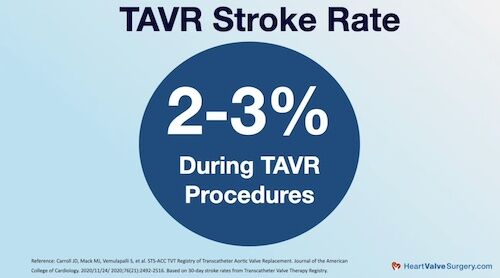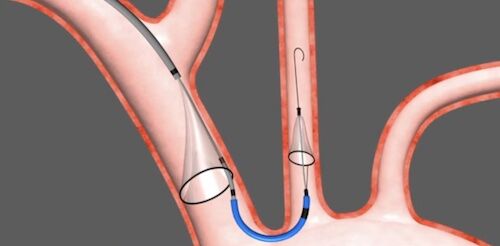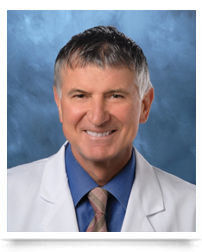Doctor Q&A: Stroke Risk & Prevention During Transcatheter Aortic Valve Replacement (TAVR)
Written By: Allison DeMajistre, BSN, RN, CCRN
Medical Expert: Kendra Grubb, MD, Surgical Director, Emory Structural Heart & Valve Center
Reviewed By: Adam Pick, Patient Advocate, Author & Website Founder
Published: July 29, 2024
The treatment of aortic valve stenosis has transformed with the advent of the transcatheter aortic valve replacement (TAVR) procedure. Originally approved for patients who were too high risk to tolerate open heart surgery, TAVR is now received approval for patients at all surgical risk levels. In many instances, this minimally-invasive approach allows patients to go home the next day after the procedure1, and most patients can take care of themselves better, go back to their everyday activities and tend to have a faster recovery compared to open heart surgery2.
However, TAVR is not perfect. Like many cardiac procedures, including surgical aortic valve replacement, TAVR comes with the risk of stroke during the procedure. Although statistics show the stroke risk is low, the threat of having a stroke during a TAVR remains a serious complication.3
To get more information about TAVR and the risk of stroke, we spoke with Dr. Kendra Grubb, the surgical director of the Emory Structural Heart and Valve Center at Emory Healthcare in Atlanta, Georgia. Dr. Grubb has performed over a thousand cardiac surgeries and TAVRs. In fact, she was scheduled to perform three procedures the day she spoke with us.
Key Learnings About Stroke Risk and TAVR
- The rate of stroke remains stable. Grubb stated, “The stroke rate has been pretty stable for a number of years. Initially, there was a higher stroke rate with TAVR than with surgery, but that’s not true anymore. The rate of stroke is about two to three percent, and it has been for a really long time. With modern devices and modern techniques, that rate is probably closer to two.”3

- Cerebral protection devices can help decrease the rate of disabling stroke. Grubb told us, “We do have cerebral protection devices or brain protection devices that put little baskets in the arteries that go to the brain. Those trials have shown that it decreases the rates of disabling strokes – so the ones that count.4

- Clinical trial research is being conducted to evaluate new devices that may help reduce the stroke risk. “The data right now does not necessarily support the use of embolic protection devices,” Dr. Grubb said. “There are newer devices in trial that may show a bigger difference. Even the commercially available device, the Sentinel Cerebral Protection Device, has some data to say that it’s worth doing.”
What is Dr. Grubb’s advice for patients concerned about stroke during TAVR? Dr. Grubb stated, “My advice to patients is to have the conversation with your doctor, understand the data, understand if you think that this is something that will benefit you. Your doctor will look at your CT scan and be able to tell you if you’re at a higher risk for having a stroke and then make the decision and share decision-making with the team that’s taking care of you.” TAVR risks may include, but are not limited to, death, stroke, damage to the arteries, bleeding and need for permanent pacemaker.
The statements and information presented herein may be the opinion of the individual physician featured and is not intended to constitute medical advice.
Thanks Dr. Grubb and Emory Structural Heart and Valve Center!
On behalf of the patients at HeartValveSurgery.com and all over the world, thank you, Dr. Grubb, for sharing your expert knowledge and advice about TAVR, stroke, and cerebral protection devices.
Related Links:
- Medtronic TAVR Procedure: What Should Patients Know?
- TAVR Heart Team Finder
- Clinical Trial Update: 4-Year Results for Low-Risk TAVR Clinical Trial
Keep on tickin!
Adam
P.S. For the deaf and hard-of-hearing members of our patient community, I have provided a transcript of this interview with Dr. Grubb below.
References:
1 Batchelor WB, Sanchez CE, Sorajja P, et al. Temporal Trends, Outcomes, and Predictors of Next-Day Discharge and Readmission Following Uncomplicated Evolut Transcatheter Aortic Valve Replacement: A Propensity Score-Matched Analysis. J Am Heart Assoc. May 7 2024;13(9):e033846.
2 Kleiman NS, Van Mieghem NM, Reardon MJ, et al. Quality of Life 5 Years Following Transfemoral TAVR or SAVR in Intermediate Risk Patients. JACC Cardiovasc Interv. Apr 22 2024;17(8):979-988.
3 Carroll JD, Mack MJ, Vemulapalli S, et al. STS-ACC TVT Registry of Transcatheter Aortic Valve Replacement. Journal of the American College of Cardiology. 2020/11/24/ 2020;76(21):2492-2516. Based on 30-day stroke rates from Transcatheter Valve Therapy Registry.
4 Wolfrum M, Handerer IJ, Moccetti F, Schmeisser A, Braun-Dullaeus RC, Toggweiler S. Cerebral embolic protection during transcatheter aortic valve replacement: a systematic review and meta-analysis of propensity score matched and randomized controlled trials using the Sentinel cerebral embolic protection device. BMC Cardiovasc Disord. 2023 Jun 17;23(1):306.
Video Transcript
Adam: Hi everybody, it’s Adam with heartvalvesurgery.com. This is a special surgeon question and answer session all about transcatheter aortic valve replacement and stroke risk. I am thrilled to be joined by Dr. Kendra Grubb, who is the surgical director of the Emory Structural Heart and Valve Center at Emory Healthcare in Atlanta, Georgia. During her extraordinary career, Dr. Grubb, has performed over a thousand cardiac surgeries and more than a thousand TAVRs. Dr. Grubb, it is great to see you again and thanks so much for being with me today.
Dr. Grubb: Thank you.
Adam: Dr. Grubb, we’ve been having an ongoing conversation at heartvalvesurgery.com about stroke risk in TAVR. I’m real curious, you do a lot of TAVR. I think you’re going to do three TAVR procedures today. Can you give our community an update about the stroke rate for patients undergoing TAVR?
Dr. Grubb: Sure. The stroke rate has been pretty stable for a number of years. Initially there was a higher stroke rate with TAVR than with surgery, but that’s not true anymore. The rate of stroke is about two to 3%, and it has been for a really long time. With modern devices and modern techniques, that rate is probably closer to two. We do have cerebral protection devices or brain protection devices that put little baskets in the arteries that go to the brain. Those trials have shown that it decreases the rates of disabling strokes, so the ones that count but overall strokes are about the same, about 2%.
Adam: Your advice for patients who are concerned about stroke during TAVR is what?
Dr. Grubb: The data right now does not necessarily support the use of embolic protection devices. There are newer devices in trial that may show a bigger difference. Even the device that’s commercially available, the Sentinel Cerebral Protection Device, there is some data to say that it’s worth doing. My advice to patients is have the conversation with your doctor, understand the data, understand if you think that this is something that will benefit you. Your doctor will look at your CT scan and they will be able to tell you if they think that you’re higher risk for having a stroke and then make the decision and share decision making with the team that’s taking care of you.
Adam: Dr. Grubb, that is really important advice. On behalf of all the patients at heartvalvesurgery.com, patients all over the world, thanks so much to you and your team for everything you’re doing for the treatment of aortic stenosis with TAVR.
Dr. Grubb: Thank you.




